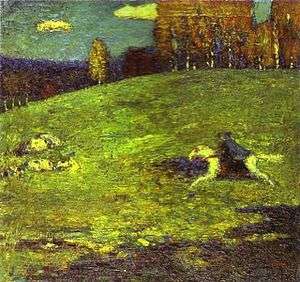The Blue Rider (Kandinsky painting)
The Blue Rider (German:Der Blaue Reiter) is an oil painting executed in Bavaria in 1903 by the Russian emigré artist Wassily Kandinsky. It is held in a private collection.
| The Blue Rider | |
|---|---|
| German: Der Blaue Reiter | |
 | |
| Artist | Wassily Kandinsky |
| Year | 1903 |
| Medium | oil on card |
| Dimensions | 55 cm × 60 cm (22 in × 24 in) |
It depicts a horseman in a blue cloak galloping through a meadow on a white horse with a forest in the background. The painting itself is unremarkable but represented an important milestone on Kandinsky's artistic transition from impressionism to modern abstract art, of which he was one of the pioneers. It was one of his last impressionist works and contains early signs of the abstractionism that would become his forte. The color blue in particular was to have a spiritual significance for the artist. [1]
The other significance of the work is that it shared its German title (Der Blaue Reiter) with the name of the group of progressive artists founded by Kandinsky in 1911 which published an almanac and organised exhibitions of their work.
References
- "The Blue Rider by Wassily Kandinsky". kandinskypaintings.org. Retrieved 9 August 2020.